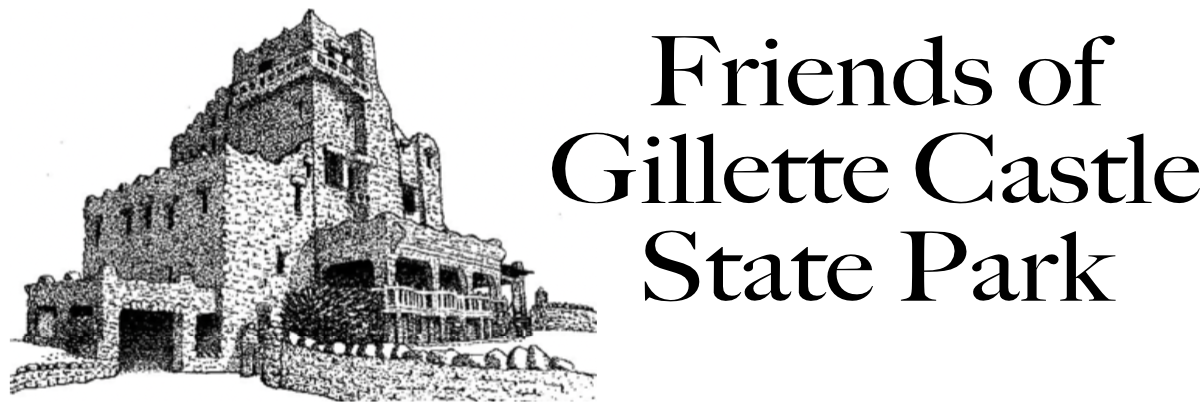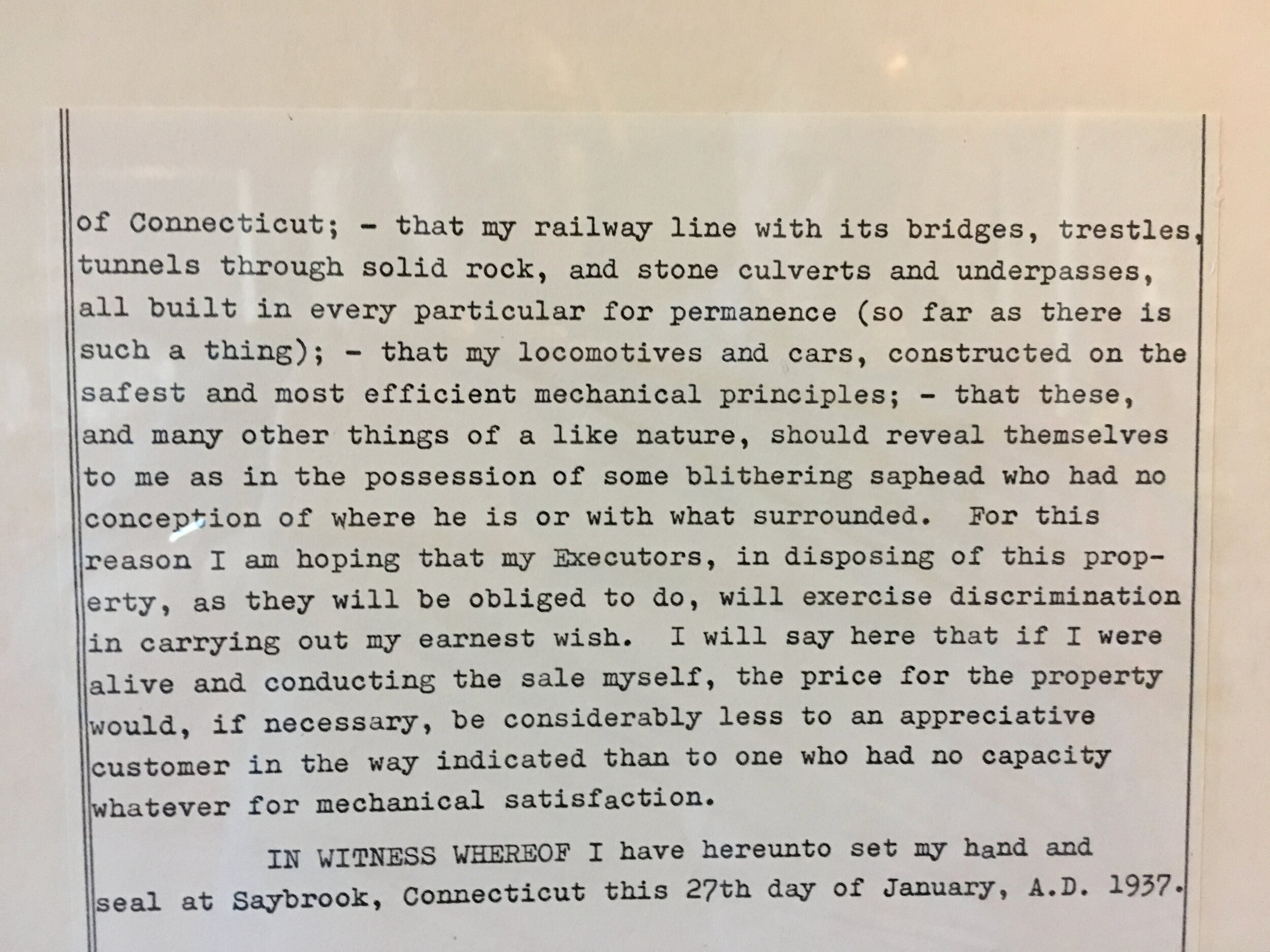A Gillette Timeline
~ Notable dates in the legacy of William H. Gillette (1853-1937) ~
Click on images to expand.
1850s
July 24, 1853 – Birth of William Hooker Gillette in Hartford, Connecticut. The Gillette family lives in Hartford's Nook Farm area, where their neighbors include authors Harriet Beecher Stowe and Samuel Clemens (Mark Twain).
1870s
1873 – Gillette leaves Hartford to become an actor, finding work in St. Louis and New Orleans.
1875-1876 – In Boston, Gillette plays his first significant role in “Faint Heart Ne'er Won Fair Lady.” He enrolls in Boston University's School of Oratory.
September 1876 – Gillette begins a two-year tour of the western U.S. states with McCauley's Stock Company.
Sept. 30, 1879 – Francis Gillette, father of William Gillette, dies in Hartford, Connecticut.
1880s
January 1880 – Gillette’s first full-length play, “The Professor,” is advertised on the front page of the Hartford Courant.
1881-1882 – Gillette and Frances Hodgson Burnett adapt her novel Esmerelda for the stage.
June 1, 1882 – Gillette marries Helen Nichols, 21, a native of Detroit, Michigan, in nearby Windsor, Ontario, where her mother and stepfather live.
1882-1888 – The newlyweds tour the U.S. by rail while Gillette stars in his own plays, including “The Professor” and “The Private Secretary.” Meanwhile, he writes a five-act melodrama, “Held by the Enemy.”
Dec. 4, 1883 – Gillette patents a “time stamp” that “stamps upon the upper surface of papers a dial and one or more dial-pointers, representing the time of day.” He later receives similar patents for updates.
Feb. 22, 1886 – “Held by the Enemy” is produced at the Criterion Theater in Brooklyn. In August, it opens in the Madison Square Theatre in Manhattan, then travels to the Boston Museum.
May 1887 – “Held by the Enemy” opens at London's Princess Theatre.
Nov. 29, 1887 – Gillette's adaptation of H. Rider Haggard's novel “She” opens at Niblo's Garden in New York City.
Aug. 14, 1888 – Gillette's original play “A Legal Wreck” opens at New York City's Madison Square Theatre.
Sept. 1, 1888 – Helen Nichols Gillette, 28, dies of peritonitis in Cos Cob, Connecticut, while en route to Hartford. Gillette, 35, never remarries. The couple are childless.
Sept. 11, 1888 – Gillette patents “a new and useful Improvement in Methods of Producing Stage Effects in Imitation of the Sounds Made by Horses' Feet.”
Late 1888 to early 1893 – Gillette withdraws from the stage and builds a rustic home in North Carolina. In poor health and mourning his wife, he lives in seclusion there and in Hartford.
1890s
Feb. 6, 1893 – Gillette's original play “Ninety Days” opens at the Broadway Theatre in New York City. The elaborate production costs Gillette most of his savings when it closes March 18.
Dec. 16, 1893 – Elisabeth Hooker Gillette, 80, mother of William Gillette, dies in Hartford.
December 1893 – Gillette befriends the impresario Charles Frohman and returns to acting.
Nov. 26, 1894 – Gillette stars at the Standard Theatre in New York City in “Too Much Johnson,” adapted by him from the French farce “La Plantation Thomassin.”
May 13, 1895 – “Secret Service,” Gillette’s most dramatically significant play, opens at the Broad Street Theatre in Philadelphia and runs for two weeks, starring Maurice Barrymore in a dual role.
Oct. 5, 1896 – “Secret Service” opens at New York’s Garrick Theatre, Gillette replacing the ailing Barrymore.
March 6, 1897 – “Secret Service” closes and moves to the Adelphi Theatre in London, England.
During 1898 – Charles Frohman arranges for Gillette to rewrite Arthur Conan Doyle's draft of a play featuring Sherlock Holmes.
Nov. 23, 1898 – A deadly fire sweeps the Baldwin Hotel and Theater in San Francisco on the night Gillette rejoins his company. The “Secret Service” sets and costumes are destroyed, as is the only copy of the “Sherlock Holmes” script. Gillette reconstructs the script from memory.
May 20-21, 1899 – Gillette visits Doyle’s home in Hindhead, Surrey, and wins approval for his revised version of “Sherlock Holmes.”
Oct. 23, 1899 – “Sherlock Holmes” begins tryouts at the Star Theatre in Buffalo, New York.
Nov. 6, 1899 – “Sherlock Holmes” premieres. The play runs for 235 sold-out performances at the Garrick Theatre, New York City.
1900s
About 1900 – Gillette buys the “Aunt Polly,” a houseboat that becomes his home for several years. Yukitaka Osaki of Japan is engaged to serve on the boat and subsequently becomes Gillette's valet and stage dresser.
Sept. 9, 1901 – “Sherlock Holmes” begins a sold-out 216-performance run at London's Lyceum Theatre.
Sept. 26, 1903 – American illustrator Frederic Dorr Steele begins a famous series of drawings for Collier's magazine, basing his conception of Holmes on Gillette.
Nov. 17, 1903 – Gillette stars as Crichton the butler in James Barrie's play “The Admirable Crichton.”
October 1904 – Gillette completes a four-part play, “Ticey, or That Little Affair of Boyd's,” which plays four years later in Washington, D.C., and New York City.
March 24, 1905 – Gillette's curtain-raiser “The Painful Predicament of Sherlock Holmes” premieres during a benefit performance at New York City's Metropolitan Opera House.
January 1908 – Gillette begins buying hilltop land overlooking the Connecticut River as the site of his future retirement home. After a dozen transactions through 1917, Gillette's estate amounts to 122 acres.
Oct. 19, 1908 – At the Criterion Theatre in New York City, Gillette begins playing the taxing lead role in Henri Bernstein's play “Samson,” causing a health breakdown that forces a nearly two-year retreat from acting and writing.
1910s
Sept. 26, 1910 – Gillette's last significant play as a writer, “Electricity,” opens at the Park Theatre in Boston, followed by a run at New York City's Lyceum Theatre.
1912 – Gillette stumps for former President Theodore Roosevelt, running again on behalf of the Bull Moose Party.
During 1914 – Construction begins on “Seventh Sister,” with Gillette designing his future home and overseeing its construction by the Porteus-Walker Company of Hartford, Connecticut.
Oct. 20, 1914 – Gillette opens an extended tour in Chicago of his modernization of French dramatist Victorien Sardou's “Diplomacy.”
November 1915 – Gillette is elected to the American Academy of Arts and Sciences, the second playwright so honored by the elite 50-member group.
1916 – Essanay Studios releases “Sherlock Holmes,” a silent film in which Gillette stars at age 63.
Feb. 5, 1917 – Gillette appears in Clare Kummer's play “A Successful Calamity” at the Booth Theatre in New York.
Dec. 23, 1918 – Gillette appears in James Barrie's “Dear Brutus,” partnering in a significant scene with the ingenue Helen Hayes during the early days of the play’s run.
During 1919 – Gillette begins moving from the “Aunt Polly” into the recently completed “Seventh Sister,” completing the process in 1922. An addition to the structure is finished in 1926.
1920s
Nov. 21, 1921 – Gillette's thriller “The Dream Maker” opens at New York City's Empire Theatre. The play is Gillette's final Broadway production.
Jan. 8, 1923 – A revival tour of “Sherlock Holmes” opens at Philadelphia's Broad Street Theatre.
May 14, 1923 – Gillette's last produced play, a short called “Winnie and the Wolves,” is presented at Philadelphia's Lyric Theatre.
Aug. 9, 1925 – At 72, Gillette accidentally crashes his Ner-A-Car motorcycle into an automobile. He is rendered unconscious when thrown from the vehicle, and sustains lacerations to his head and knee.
During 1927 – Harper & Brothers of New York publishes Gillette's novel, “The Astounding Crime on Torrington Road.”
During 1927 – Gillette constructs a miniature railroad on his estate. After his death, the equipment is sold to Lake Compounce in 1943.
Oct. 25, 1929 – A “farewell tour” of “Sherlock Holmes” begins Nov. 15, 1929, running through May 12, 1930.
1930s
Oct. 20, 1930 – At 77, Gillette performs as Holmes in a radio adaptation of Sir Arthur Conan Doyle's story “The Adventure of the Speckled Band,” on New York City-based WEAF-NBC.
Around Nov. 14, 1931 – The National Institute of Arts and Letters gives Gillette its gold medal for his work as a dramatic author. This honor is in addition to honorary degrees from Columbia University, Trinity College, Dartmouth College and Yale University.
May 12, 1932 – Gillette makes his final in-person appearance as Holmes at the McCarter Theatre in Princeton, N.J. Eccentrically, he bids the audience a “Merry Christmas and a Happy New Year.”
Dec. 20, 1932 – The “Aunt Polly” burns at its mooring below “Seventh Sister.” The blaze's cause remains undetermined. The wreck becomes the focus of archeological studies in 2003.
Dec. 7, 1934 – At Chris Cella's restaurant in New York City, Gillette attends the second dinner meeting of the recently formed Baker Street Irregulars, a group of Sherlock Holmes admirers.
Feb. 27, 1936 – Gillette makes his final stage appearance in Austin Strong's comedy “Three Wise Fools” at Bushnell Memorial Hall in Hartford. See a related article at ConnecticutHistory.org
During December 1936 – Gillette is admitted to Hartford Hospital in Connecticut for treatment of a severe cold. He returns home shortly thereafter.
April 29, 1937 – At 83, William Hooker Gillette dies of a pulmonary hemorrhage. He is buried beside his wife in the Hooker family plot at Riverside Cemetery, Farmington, Connecticut.
Oct. 15, 1938 – Gillette's retirement home and estate are sold at auction for $35,000. The executors and their bank subsequently reject the bid. The property's status remains in limbo for about five years.
1940s
During late 1943 – The State of Connecticut, with help from the Connecticut Forest and Parks Association, purchases the Gillette estate for $30,000.
Oct. 7, 1944 – Gillette's home and surrounding property are opened to the public as Gillette Castle State Park.
This compilation is drawn from multiple published sources and is not the product of original research. No claim to originality is made, although we have sought to present the information in a fresh, accessible format.
Sources include publications distributed by the state of Connecticut, the Friends of Gillette Castle State Park and fair-use material from published works focusing on the lives and writings of Arthur Conan Doyle and William Gillette. These include “A Sherlock Holmes Almanac” by Sven Petersen et al (Battered Silicon Dispatch Box, 2002), Doris E. Cook's “Sherlock Holmes & Much More” (Connecticut Historical Society, 1970), Daniel Stashower's “Teller of Tales, The Life of Arthur Conan Doyle” (Henry Holt and Company, 1999) and Henry Zecher's “William Gillette, America's Sherlock Holmes” (Xlibris Press, 2011). Show posters are from the Library of Congress Prints and Photographs division.
The compilation was undertaken by John C. Sherwood of MysteryVisits Communications on behalf of the Friends of Gillette Castle State Park, with fact-checking and editing support by additional Friends of Gillette Castle State Park volunteers.

















































